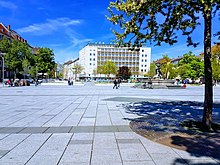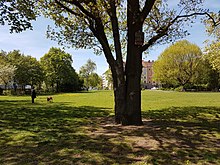Südstadt (Nuremberg)
The Südstadt is a large district of Nuremberg and comprises the inner-city areas adjoining the main train station to the south .
The south city
The central location, low property prices and a large number of apartments make the district attractive. The streets of the Südstadt are lively and show a wide range of shops and restaurants of different nationalities. Many shops are concentrated around the pedestrian zone on Aufseßplatz . In large parts it is very well developed for public transport by underground and tram .
The Südstadt has a high population density, with a high proportion of migrants and used to be a distinct working-class district. In the west and south there are extensive, often old industrial production and commercial sites, some of which have been given new uses in recent years. The Südstadt has a dense development, the proportion of green spaces is low, and street trees are rare. Combined with a large volume of car traffic, there is a high level of air pollution .
The population density in "Statistical District 2 (Südstadt)" is around 12,300 inhabitants / km², well above the Nuremberg average of 2,700. According to an analysis by the Statistical Office and the Federal Employment Agency, 30.6 percent of residents under 65 years of age in the statistical district of Dianaplatz received basic security for jobseekers according to SGB II ( social assistance ). In the other statistical districts belonging to Südstadt, the proportion of recipients of unemployment benefit II and social benefits was between 15.2 and 23.4 percent and thus above the city's average of 11.3 percent - which is high in Bavarian comparison. The only exception is the statistical district of Guntherstrasse (8.7 percent), which forms the northern part of the so-called Nibelungenviertel.
The proportion of migrants in the Südstadt is 28.8 percent. This is noticeable in the streetscape, the languages and in the international range of shops and also at the annual Südstadtfest.
Variants of the area delimitation
There are different demarcations, colloquially the area between Münchner Straße / Hainstraße / Regensburger Straße in the east, Frankenschnellweg in the west, railway embankment with the main train station in the north and Franken- / Ulmenstraße in the south is meant.
In the 1981 urban development report of Nuremberg, the borders in the south extend to the marshalling yard and also include Gibitzenhof and Hasenbuck .
The definition of the EU target 2 funding area includes Werderau and Sandreuth in the west .
The “Statistical District 2 (Südstadt)” is used for statistical purposes; it includes the statistical districts of Glockenhof , Guntherstrasse , Galgenhof , Hummelstein , Gugelstrasse , Steinbühl , Gibitzenhof , Hasenbuck , marshalling yard , Katzwanger Strasse and Dianastrasse .
history
The southern part of the city developed from 1830, when numerous businesses expanded from the old town to the often independent communities in the south of Nuremberg. The construction of the main train station in 1845/46 promoted this development. Between 1825 and 1900, Tafelhof, Steinbühl, Gibitzenhof, Lichtenhof, Hummelstein, Hasenbuck, Gleißhammer, St.Peter, Glockenhof and Galgenhof were incorporated.
In contrast to the northern part of the city, the southern part of the city is characterized by a mixed development with a high proportion of commercial and factory sites and mostly multi-storey residential developments. In 1889 the Schuckertwerke built large pieces of land on Landgrabenstrasse. MAN set up large-scale production facilities south of the Ringstrasse .
During the First World War, production was converted to war needs, particularly through the Hindenburg program from 1916. MAN manufactured guns, engines and trucks, Siemens-Schuckert manufactured headlights and power generators for submarines.
The TeKaDe manufactured radios from 1924 in the Allersberger road. In 1926 the Nuremberg branch of the Schocken department store was opened on Aufseßplatz. It was considered a milestone in “New Building” in Nuremberg.
Armaments were produced again in World War II: MAN built submarine engines and a large part of the Panther tanks , for example ; their number of employees rose from 2,800 at the beginning of 1934 to 6,530 at the beginning of 1940. Due to the production facilities, the railway facilities of the main station in the north and the marshalling yard in the south, the southern part of the city became an important target for Allied bombing raids ; Thousands of people were killed and innumerable houses destroyed.
After the war, the houses were quickly and easily rebuilt, and many streets now seem monotonous. After the reconstruction, the industry soon returned to its old position and attracted many guest workers . With the decline of classic industry in the 1970s, the decline of Südstadt began. Many traditional companies had to close and many workers were made redundant.
The re-use of old industrial areas has been an important goal of Nuremberg's urban development since then. One example is the Nürbanum on the former Philips / TeKaDe site or the FrankenCampus on the former MAN administration site on Frankenstrasse.
An attempt is being made to revitalize the southern part of the city with various funding programs, for example as part of the European Union's objective 2 funding . The projects included - in addition to many playground redesigns and smaller measures - among others:
- the establishment of the Südstadtpark in 2002.
- the redesign of the Aufsessplatz in 2007.
- the reopening of the renovated and redesigned Südstadtbad in 2008.
- the opening of the "Südpunkt" as a house for education and culture in 2009.
Events
The Südstadtfest is the largest district festival in Nuremberg with approx. 80,000 visitors and in Annapark offers information, a wide range of multicultural offers, street booths and an event stage. During the day, clubs in the southern part of the city show a cross-section of their activities, while concerts take place in the evenings. The Südstadtfest was held for the first time in 1981, at that time on Kopernikusplatz .
Since 2005, the Spirit Asia has been held in the Südstadtpark , an open-air festival with bud part and stages. On the one hand, Spirit Asia was intended to help revitalize the southern part of the city; on the other, initiated by the economic department, it was intended to strengthen the modern location profile of Nuremberg. According to the company, “the largest Asian market in Germany” lasted three days and in 2009 attracted over 60,000 visitors. In 2010 the Spirit Asia was canceled due to a lack of sponsors.
The street festival against racism has been taking place on Aufseßplatz since 2015 . It is committed to a better coexistence of all people of different religions, ethnicities, languages and cultures.
literature
- Bernd Windsheimer et al. (Ed.): Gibitzenhof - Werderau - Sandreuth . Sandberg Verlag, Nuremberg 2010, ISBN 978-3-930699-64-3 .
Web links
- suedstadtnuernberg.de - Private page to Südstadt
- suedstadt.nuernberg.de - Official site of the city for target 2 funding
- suedpunkt.de - forum for education and culture
Individual evidence
- Michael Diefenbacher , Rudolf Endres (Hrsg.): Stadtlexikon Nürnberg . 2nd, improved edition. W. Tümmels Verlag, Nuremberg 2000, ISBN 3-921590-69-8 ( online ).
- Other sources
- ↑ City within the city. (No longer available online.) In: nuerbanum.de. Nürbanum Liegenschaften GbR, archived from the original on April 1, 2011 ; Retrieved December 7, 2010 . Info: The archive link was inserted automatically and has not yet been checked. Please check the original and archive link according to the instructions and then remove this notice.
- ↑ http://www.kib-projekt.de/frankencampus/
- ↑ Archived copy ( Memento of the original dated December 29, 2008 in the Internet Archive ) Info: The archive link has been inserted automatically and has not yet been checked. Please check the original and archive link according to the instructions and then remove this notice.
- ^ Website of the Südstadtbad with current information
- ↑ http://www.suedpunkt-nuernberg.de/
- ↑ https://www.suedstadtfest.de/index.php/ueber-das-fest/geschichtliches
- ↑ http://www.spirit-asia.de/text/history.html
- ^ Off for "Spirit Asia". Retrieved June 12, 2019 .


